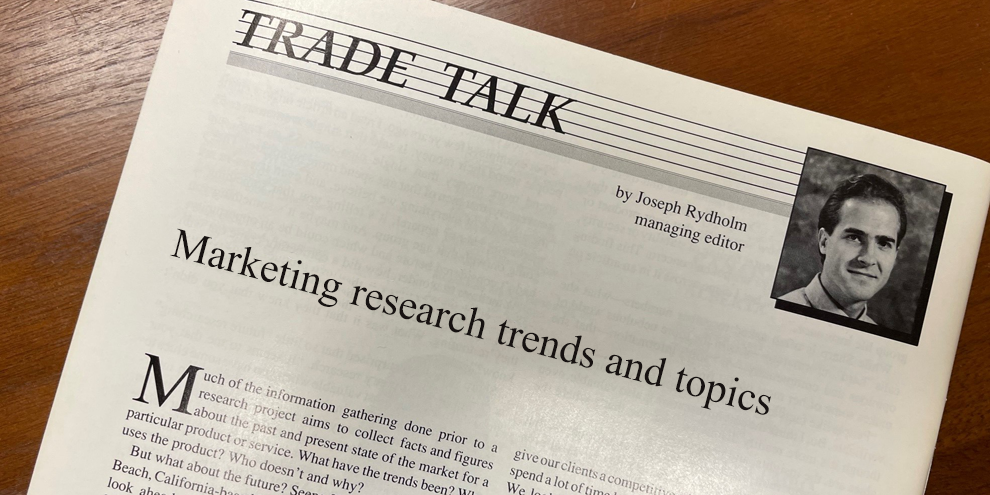The service gospel continues to spread, and it's reaching some unlikely places - such as your neighborhood church. We're accustomed to hearing about how important it is for businesses and other service organizations to survey their customers. But churches? It makes sense, because they do provide a number of services (no pun intended) to their congregations, and if those services are unsatisfactory, people may go elsewhere.
One church that is using research to meet the needs of its congregation is Rosewood Church, a Christian Reformed church located in Bellflower, California, a inner-ring, middle-class suburb of Los Angeles.
Tim Kauffman, associate pastor, says that for the past five years the church has been undergoing a revitalization effort to draw new congregation members and spark the interest of current ones.
A key to that effort has been adding a contemporary worship service to the traditional service. Kauffman says that while the pastor's message is the same for both services, there are a number of differences between the contemporary and traditional services. In the traditional service, hymns are sung from song books accompanied by an organ. The contemporary service is upbeat, with praise music sung to a band featuring a synthesizer, guitar, bass and drums.
"In the traditional service the focus is on paying homage to an awesome God. The focus is more toward experiencing the presence of Jesus in the second service. It's a whole different mix of the ways you experience God in worship," Kauffman says.
Controversy
Though the contemporary service has been quite successful, it has brought about some controversy, so the church administration decided to survey the congregation to get a handle on people's attitudes and opinions.
"We came to a juncture where we had to make some decisions about our direction because the attendance at the contemporary service increased quite a bit and the traditional service decreased. We wanted to assess what was drawing people. In addition, there were people connected to the church with very different feelings about what was working and what wasn't and why. We looked at the survey as a way to answer some of those questions."
A four page survey was sent to over 400 members including groups of regular attenders, occasional attenders and younger church members. The survey asked respondents for their opinions on various aspects of the two services and gathered information on their attendance habits. Respondents used a scale from 1 to 5, 1 indicating that they felt the aspect in question enriched their churchgoing experience, 3 that they were neutral toward it, and 5 that it hindered their experience. Kauffman used Raosoft Survey, a software program from Seattle-based Raosoft Inc., to create the questionnaire and analyze the results.
"We built a database of all the responses and then did a comparative analysis. We wanted to track what the preferences were in the two worship services. We did some age breakdowns to find out generational differences. Using Raosoft we generated a mean for each question and plotted them. Those were distributed to the administrative board who will make the ultimate decision on what will happen."
Generational lines
The survey found that opinions were generally drawn along generational lines, with the congregation members 65 and older favoring the traditional service and the baby boomers preferring the contemporary service. And the data showed that newer congregation members, those who had been at the church for five years or less, preferred the contemporary service. This finding was important for the church's effort in attracting new families to worship.
"We want to and try to be as market sensitive as we can in that respect. I think it was a valuable survey to do and I think it helped the leadership understand where people were at. It was helpful to get a read on things and confirm some of the hunches we had. We had some fairly substantial hypotheses about why certain worship styles were working. There has been some research done on worship preferences of generations and we pretty much confirmed what those studies said in our own congregation."
Survey new members
Kauffman says that because of the importance of the attracting and keeping the younger churchgoers, the church is considering setting up a system to survey the new members who go through Rosewood's new members class.
"The way we would use this data is to make sure we are doing the things that are going to draw those new people in. If we can attract new people who are unchurched, they tend to have more friends who are unchurched, so word of mouth tends to be the best thing we have going. We wouldn't necessarily use it for advertising because our best method of advertising is word of mouth. People don't tend to show up at a church because of a mailer, they show up because somebody who's credible to them says, hey, why don't you come and give this a try.
"American churches are very competitive. Our church is trying to carve out a niche. There are many other churches in our area and they're trying to grow, just as we are. We're trying to make our niche by attracting people that don't necessarily go to church very often. I think it helps us to be sensitive to what those people are looking for in a church and I think that's really the overall benefit of the survey we're going to be administering to new people coming in. We'll find out what has worked and what hasn't.
"There's a body of literature called the church growth movement and more and more of those people are talking about being market sensitive. Now, a lot of churches resist those kinds of things. And I don't know of any other church that has done a survey of their congregation to this extent but I foresee churches doing more of this kind of thing in the future."
